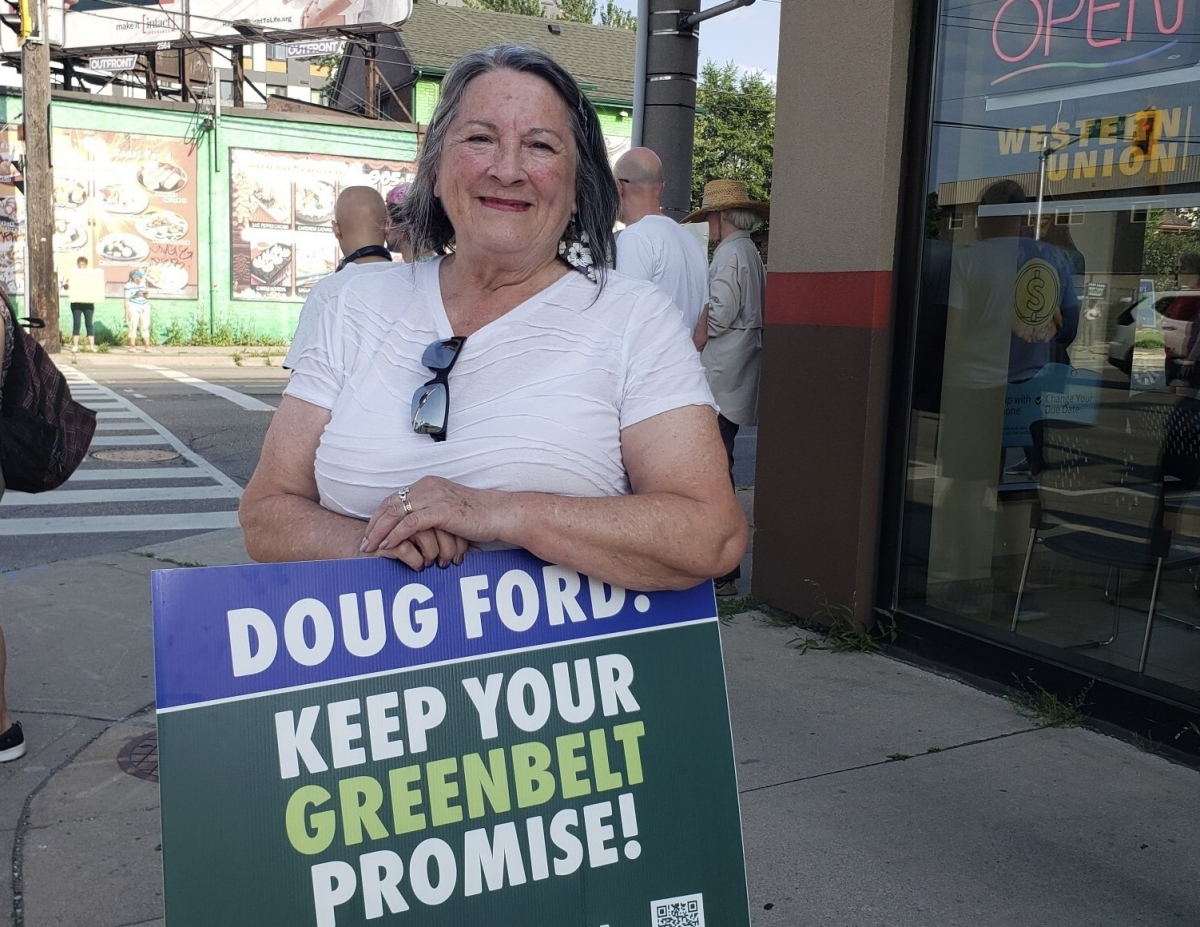Support strong Canadian climate journalism for 2025
Impassioned Hamilton residents and environmental advocates attended an anti-sprawl protest this week to push back against orders by Ontario Premier Doug Ford to build housing outside city boundaries.
Hamilton initially resisted the Ford government’s push to build additional housing in former Greenbelt lands tapped by the province for development, but was overruled late last year. Feeling cornered, Hamilton city council decided earlier this month to start meeting with the province to discuss what the development might look like.
Ted McMeekin, councillor for Flamborough Waterdown Ward 15, told Canada’s National Observer engaging with a provincial facilitator may be the only opportunity the city has to articulate the massive opposition to Greenbelt development. “Hamilton city council voted to proceed ‘under protest,’ but nonetheless agreed to proceed with talking to the provincial facilitator,” McMeekin added.
He noted the city conducted an extensive engagement process with residents that showed more than 90 per cent opposed expanding development in the Greenbelt, prime agricultural lands, wetlands and heritage areas. Instead of insisting on more sprawl, the province should embrace inclusive zoning, build at much higher densities along transit corridors and cheer the city’s prudent development strategies, McMeekin said.
“Hamilton would much prefer to point direction and not fingers. This is difficult when a senior level of government shows little interest in collaboration, listening and learning, and then acting in partnership with municipalities.”
Protesters at Wednesday’s rally agreed with that view but remain worried about how development will affect sprawl, wildlife habitat and food security in the area. Many were not impressed by the city’s decision to meet with the province.
“My belief is that we should not negotiate with a facilitator sent by bullies. Instead, we need to fight back using all legal means available,” said Mary Love, a resident of Hamilton who attended the protest. “If all else fails, some Hamiltonians are prepared to put ourselves at risk on the land to protect our collective future.”
Kathleen Livingston, a member of Stop Sprawl Hamilton and one of the rally organizers, agreed. “I want to fight until we win,” she said. “I'm in it for the long haul. I am even pleased to throw my body in front of a backhoe to stop the development. We're not finished by a long stretch."
Livingston said meeting with the provincial facilitator could backfire. “Our councillors have to be very cautious not to go too deeply into that facilitation process. Firstly, we don't understand and we don't even have a document that tells us what that mandate is or what the terms of reference are,” she added.

A legal challenge is already underway claiming Ford’s order instructing Hamilton to build is unlawful. In January, environmental law charity Ecojustice, on behalf of Environmental Defence, applied for a judicial review of the province’s action.
The amount of land being taken from the Greenbelt in Hamilton is nearly 1,800 acres, and there are approximately 5,400 acres of previously untouched land outside the Greenbelt that will be forced into the urban boundary, leading to further habitat loss for wildlife, said Ian Borsuk, interim executive director of Environment Hamilton.
Love said development should be restricted on all land beyond the former city boundary. “Studies have already shown that there is sufficient land within the boundary to accommodate the housing needs for the time frame discussed by Ford,” she said.
Borsuk agrees more housing is needed. “We need to build housing, but not just houses,” he said. Housing must be attainable, affordable and constructed where services exist, he added. “People want to live near transit, work and schools. I really think that Doug Ford is wrong in opening the Greenbelt and prime agricultural land for development.”
The protesters echoed conservationists’ fears that building on the Greenbelt and farmland poses a significant risk to species that depend on the land for habitat.
They are urging the federal government to expand its environmental impact assessment to cover the entire Greenbelt and all farmland targeted for development. So far, a federal assessment has been ordered for only one portion of the Greenbelt lands removed for development in an area surrounding Rouge National Urban Park. The assessment will cover the Duffins Rouge Agricultural Preserve, an area of farmland located on the other side of Toronto, 120 kilometres northeast of Hamilton.
“I have particular concerns about species at risk, such as amphibians and others like them. What we would really like to see is the federal government expanding the scope of their environmental impact assessment study beyond the Rouge Park. The same concerns are valid across the entire province where the Greenbelt is located,” said Borsuk.
Committee and council underscored the primacy of protecting agricultural lands, natural heritage and wetlands, said Maureen Wilson, councillor for Ainslie Wood, Kirkendall, Strathcona and Westdale Ward 1. “But it is unclear how discussions with the facilitator will proceed, and I am unsure whether the ‘mandate’ given to city staff enables them to negotiate. These conditions serve to undermine public trust and transparency. That’s why it’s stinky and murky.”
To address the ongoing housing crisis, the Ontario government plans to build 1.5 million new homes across the province in 10 years. Part of that plan involves removing 7,400 acres of protected land from the Greenbelt, which the provincial government rationalizes with its commitment to add another 9,400 acres to the Greenbelt elsewhere.
However, Wilson argues: “It is a fact that the Greenbelt lands are not needed to achieve the Government of Ontario’s stated goal of 1.5 million homes.” Two of the three Greenbelt parcels located in Hamilton lack the essential infrastructure needed for development, and the city never discussed adding such infrastructure, Wilson said, because some of that land is “rich in natural heritage features that prohibited development.”
This story was produced in partnership with Journalists for Human Rights for the Afghan Journalists-in-Residence program funded by the Meta Journalism Project.






Comments